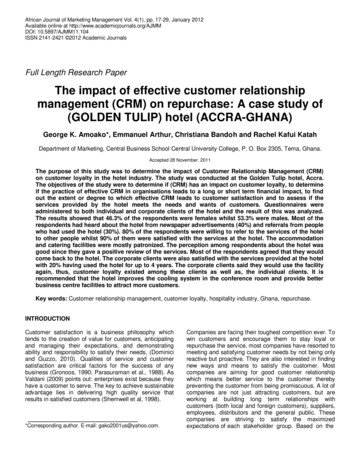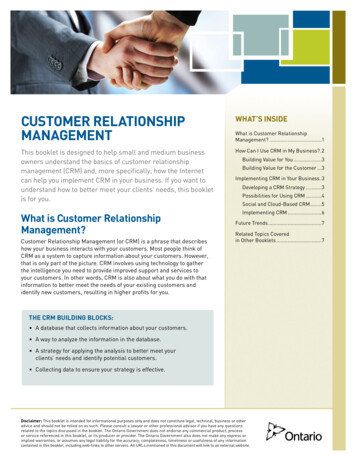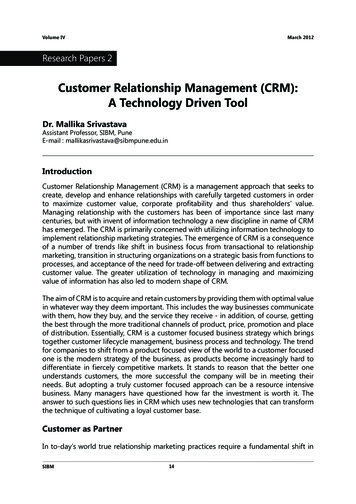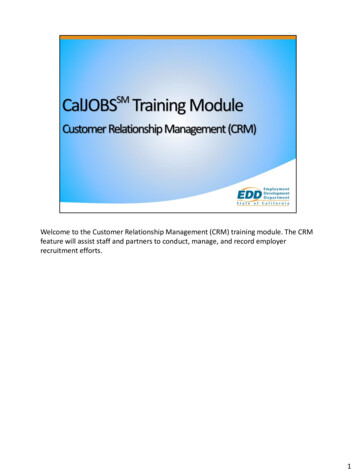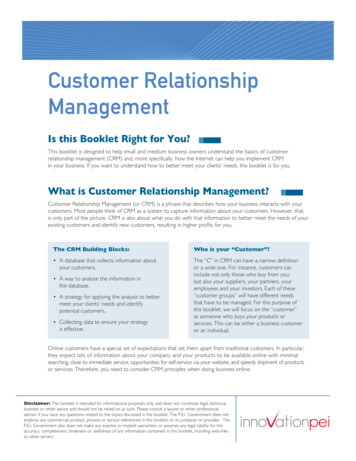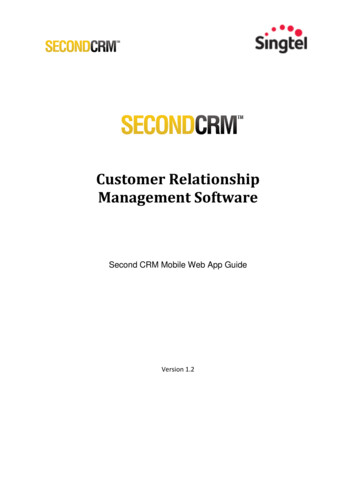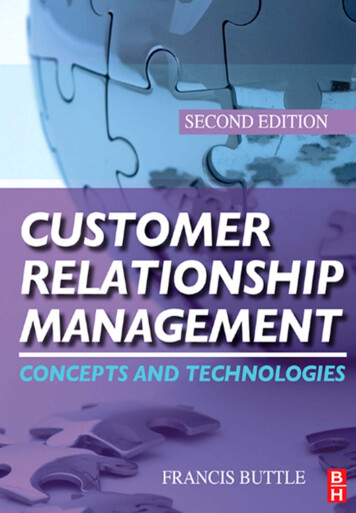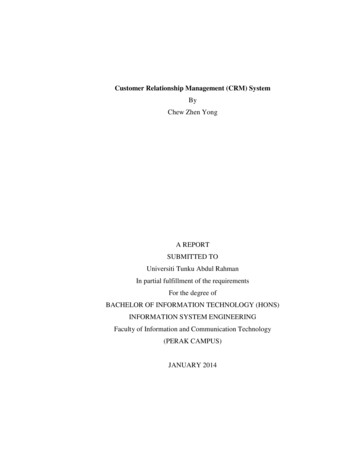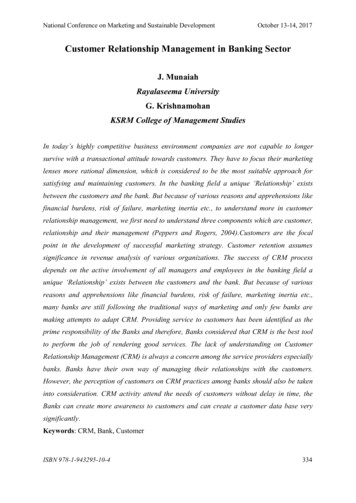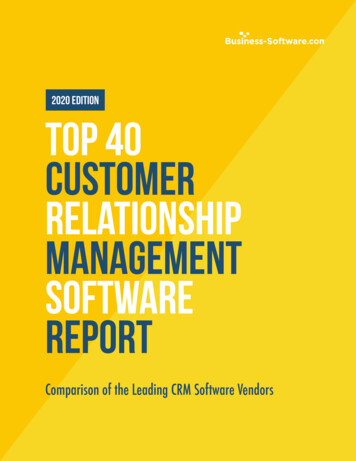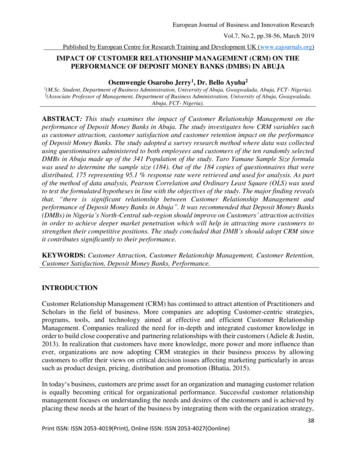
Transcription
European Journal of Business and Innovation ResearchVol.7, No.2, pp.38-56, March 2019Published by European Centre for Research Training and Development UK (www.eajournals.org)IMPACT OF CUSTOMER RELATIONSHIP MANAGEMENT (CRM) ON THEPERFORMANCE OF DEPOSIT MONEY BANKS (DMBS) IN ABUJAOsemwengie Osarobo Jerry1, Dr. Bello Ayuba21(M.Sc. Student, Department of Business Administration, University of Abuja, Gwagwalada, Abuja, FCT- Nigeria).(Associate Professor of Management, Department of Business Administration, University of Abuja, Gwagwalada,Abuja, FCT- Nigeria).2ABSTRACT: This study examines the impact of Customer Relationship Management on theperformance of Deposit Money Banks in Abuja. The study investigates how CRM variables suchas customer attraction, customer satisfaction and customer retention impact on the performanceof Deposit Money Banks. The study adopted a survey research method where data was collectedusing questionnaires administered to both employees and customers of the ten randomly selectedDMBs in Abuja made up of the 341 Population of the study. Taro Yamane Sample Size formulawas used to determine the sample size (184). Out of the 184 copies of questionnaires that weredistributed, 175 representing 95.1 % response rate were retrieved and used for analysis. As partof the method of data analysis, Pearson Correlation and Ordinary Least Square (OLS) was usedto test the formulated hypotheses in line with the objectives of the study. The major finding revealsthat, “there is significant relationship between Customer Relationship Management andperformance of Deposit Money Banks in Abuja”. It was recommended that Deposit Money Banks(DMBs) in Nigeria’s North-Central sub-region should improve on Customers’ attraction activitiesin order to achieve deeper market penetration which will help in attracting more customers tostrengthen their competitive positions. The study concluded that DMB’s should adopt CRM sinceit contributes significantly to their performance.KEYWORDS: Customer Attraction, Customer Relationship Management, Customer Retention,Customer Satisfaction, Deposit Money Banks, Performance.INTRODUCTIONCustomer Relationship Management (CRM) has continued to attract attention of Practitioners andScholars in the field of business. More companies are adopting Customer-centric strategies,programs, tools, and technology aimed at effective and efficient Customer RelationshipManagement. Companies realized the need for in-depth and integrated customer knowledge inorder to build close cooperative and partnering relationships with their customers (Adiele & Justin,2013). In realization that customers have more knowledge, more power and more influence thanever, organizations are now adopting CRM strategies in their business process by allowingcustomers to offer their views on critical decision issues affecting marketing particularly in areassuch as product design, pricing, distribution and promotion (Bhatia, 2015).In today‘s business, customers are prime asset for an organization and managing customer relationis equally becoming critical for organizational performance. Successful customer relationshipmanagement focuses on understanding the needs and desires of the customers and is achieved byplacing these needs at the heart of the business by integrating them with the organization strategy,38Print ISSN: ISSN 2053-4019(Print), Online ISSN: ISSN 2053-4027(Oonline)
European Journal of Business and Innovation ResearchVol.7, No.2, pp.38-56, March 2019Published by European Centre for Research Training and Development UK (www.eajournals.org)people, technology and business processes (Fox & Stead, 2001). Many business organizations,recognize the importance of Customer Relationship Management in attracting new customers andretaining existing ones as they are now adopting it as strategy to providing life time value tocustomers (Opara, Ayopo & Darogo, 2010).Deposit Money Banks (DMB’s) in Nigeria were not left out in the quest for better customerservices for sustainable competitive advantage; this is evident from the introduction of newproducts/services, such as ATM, POS, Mobile Banking, Internet Banking, Investment Bankingand actively participating in some corporate social responsibility activities. All these were meantto influence relationship and thereby retain their customers at a profit (Falana, 2011).In spite of the importance of CRM to the performance of many companies, DMBs in Nigeria andAbuja in particular, are yet to fully embrace the concept due largely to many operational processessuch as the inability of the DBMs to come up with effective strategies capable of attracting newcustomers, lack of effective services leading to customer dissatisfaction and subsequently,customer defection thereby loosing existing customers which impact negatively on the bank’sperformance.It is in view of this that the study was conducted to examine the impact of CRM on the performanceof DMB’s in Abuja to assess how some important CRM variables impact on their performance.Even though, similar studies were conducted in Nigeria (such as those of Okeji, 2015; Tolulope,2013; Adiele & Justin, 2013), their studies focuses on the entire DMBs in Nigeria rather than theones in Abuja, the Federal Capital Territory which this study is designed to accomplished. To thebest of our knowledge, researchers have studied only the two dimensions of CRM (i.e. customerattraction & retention). This informed our decision to focus on the four dimensions of CRM (i.e.Customer Attraction, Customer satisfaction, Customer Retention & Relationship Management).More so, most of the authors (Ayuba, 2013; Tolulope, 2013; Adiele & Justin, 2013) studieddifferent measure of performance such as ROI, Market share, sales volume, but this study use onlynet profit after tax as a measure of performance which make the study unique.The study focussed on ten (10) DMBs in Abuja, the Federal Capital Territory. Abuja was chosen,because it is where over ninety percent of the Corporate Headquarters of DMBs in Nigeria arelocated (CBN, 2015). The study covers the 5 years periods (i.e. 2011-2015); the period was chosenbecause it was during these periods that Customer Relationship Management (CRM) began to beembraced by most DMBs in Nigeria (Tolulope, 2013). The study will be of immense benefit to theManagers of DMB’s, Consultants, Researchers and Students as it will help to develop theirresearch skills and contributes to existing literature in the area. The study will also offerpractitioners, experts in customer relationship management a lot of information on relationshipmarketing strategies decisions and implementation.Research QuestionsThe following research questions were raised:i)How does Customer Attraction impact on the performance of DMBs in Abuja?39Print ISSN: ISSN 2053-4019(Print), Online ISSN: ISSN 2053-4027(Oonline)
European Journal of Business and Innovation ResearchVol.7, No.2, pp.38-56, March 2019Published by European Centre for Research Training and Development UK (www.eajournals.org)ii)To what extent does Customer Satisfaction impact on the performance of DMBs in Abuja?iii)How does Customer Retention impact on the performance of DMBs in Abuja?iv)In what way does Relationship Management impact on the performance of DMBs inAbuja?Objectives of the StudyThe main objective of this study is to evaluate the impact of Customer Relationship Managementon the Performance of Deposit Money Banks (DMBs) in Abuja. The specific objectives are to:i)Examine the impact of Customer Attraction on the performance of DMBs in Abuja.ii)Assess the impact of Customer Satisfaction on the performance of DMBs in Abuja.iii)Examine the impact of customer retention on the performance of DMBs in Abuja.iv)Ascertain the impact of relationship management on the performance of DMBs in Abuja.Statement of HypothesesIn the course of this study, the following hypotheses were formulated:Ho1: Customer Attraction does not have significant impact on the performance of DMB’s in AbujaHo2: Customer Satisfaction does not have significant impact on the performance of DMB’s inAbujaHo3: Customer Retention does not have significant impact on the performance of DMB’s in AbujaHo4: Relationship Management does not have significant impact on the performance of DMB’s inAbujaLITERATURE REVIEWConcept of Customer Relationship ManagementCustomer Relationship Management is often used interchangeably with the terms like RelationshipMarketing (RM), Customer Relationship Marketing (CRM), Enterprise Relationship Marketing(ERM), Technology Enabled Relationship Marketing’ (TERM), ‘Customer ManagedRelationships’ (CMR) or ‘Customer Management’ (CM). It is used to refer to a specific IT solutionsuch as a data warehouse or a specific application such as campaign management or sales forceautomation. The definitions and descriptions of CRM used by different authors and authoritiesvary greatly (Payne, 2005).Customer Relationship Management is the process of managing elaborates information’s aboutindividual customers and carefully managing all customers “touch point” to maximize customerloyalty (Kotler, 1991). Customer Relationship Management is a comprehensive strategy and40Print ISSN: ISSN 2053-4019(Print), Online ISSN: ISSN 2053-4027(Oonline)
European Journal of Business and Innovation ResearchVol.7, No.2, pp.38-56, March 2019Published by European Centre for Research Training and Development UK (www.eajournals.org)process of acquiring, retaining, and partnering with selective customers to create superior valuefor the company and the customer. It involves the integration of marketing, sales, customer service,and the supply-chain functions of the organization to achieve greater efficiencies and effectivenessin delivering customer value (Atul & Sheth, 2000). On the other hand, CRM is based on the basicmarketing believe that an organization should know its customer like individuals. Its componentsmay include data warehouse that store all company information, customer services system, callcenter, e-commerce, web marketing, operations system (that handle order entry, invoicing,payments, point of sale, inventory system, etc) and sales system (mobile sales communicationappointment making routine etc). In practices, CRM system range from automated customercontact system to the company wide pooling of customers information (Kottler, 1991).Kumar and Reinartz (2006) as cited by Okeji (2015) opined that CRM can be seen and discussedat three different levels i.e. functional, Customer-facing and Organizational level. At functionallevel CRM covers the processes that are required to fulfill the marketing function. Customer-facinglevel includes set of activities that provide a single view of customer across all contact channels.Organizational level is also called strategic CRM that believes in the implications of knowledgeabout their customers and their preferences for the entire organization. It provides the mostcomplete picture of the organization. From the literature it can be concluded that the element thatlead to successful implementation and operation of CRM in organization are People, Process andTechnology (Gronroose, 1990).Types of Customer Relationship ManagementButtle (2004) classified four types of customer relationship management which include StrategicCRM, Operational CRM, Analytical CRM and Collaborative CRM as discussed below.Strategic CRM: it focused upon the development of a customer-centric business culture. Thisculture is dedicated to winning and keeping customers by creating and delivering value better thancompetitors. The culture is reflected in leadership behaviors, the design of formal systems of thecompany, and the myths and stories that are created within the firm. In a customer-centric cultureyou would expect resources to be allocated where they would best enhance customer value, rewardsystems to promote employee behaviors’ that enhance customer satisfaction and retention, andcustomer information to be collected, shared and applied across the business.Operational CRM: automates and improves customer-facing and customer supporting businessprocesses. CRM software applications enable the marketing, selling and service functions to beautomated and integrated. Operational CRM cover the technological aspect of CRM. It has to dowith market automation, sales-force automation and service automation.Analytical CRM: is concerned with capturing, storing, extracting, integrating, processing,interpreting, distributing, using and reporting customer-related data to enhance both customer andcompany value. Analytical CRM builds on the foundation of customer-related information.Customer-related data may be found in enterprise-wide repositories: sales data (purchase history),financial data (payment history, credit score), marketing data (campaign response, loyalty schemedata) and service data. To these internal data can be added data from external sources:geodemographic and lifestyle data from business intelligence organizations, for example. With theapplication of data mining tools, a company can then interrogate these data.41Print ISSN: ISSN 2053-4019(Print), Online ISSN: ISSN 2053-4027(Oonline)
European Journal of Business and Innovation ResearchVol.7, No.2, pp.38-56, March 2019Published by European Centre for Research Training and Development UK (www.eajournals.org)Collaborative CRM: is the term used to describe the strategic and tactical alignment of normallyseparate enterprises in the supply chain for the more profitable identification, attraction, retentionand development of customers. For example, manufacturers of consumer goods and retailers canalign their people, processes and technologies to serve shoppers more efficiently and effectively.They employ practices such as co-marketing, category management, collaborative forecasting,joint new product development and joint market research. Collaborative CRM uses CRMtechnologies to communicate and transact across
Operational CRM: automates and improves customer-facing and customer supporting business processes. CRM software applications enable the marketing, selling and service functions to be automated and integrated. Operational CRM cover the technological aspect of CRM. It has to do with market automation, sales-force automation and service automation.
